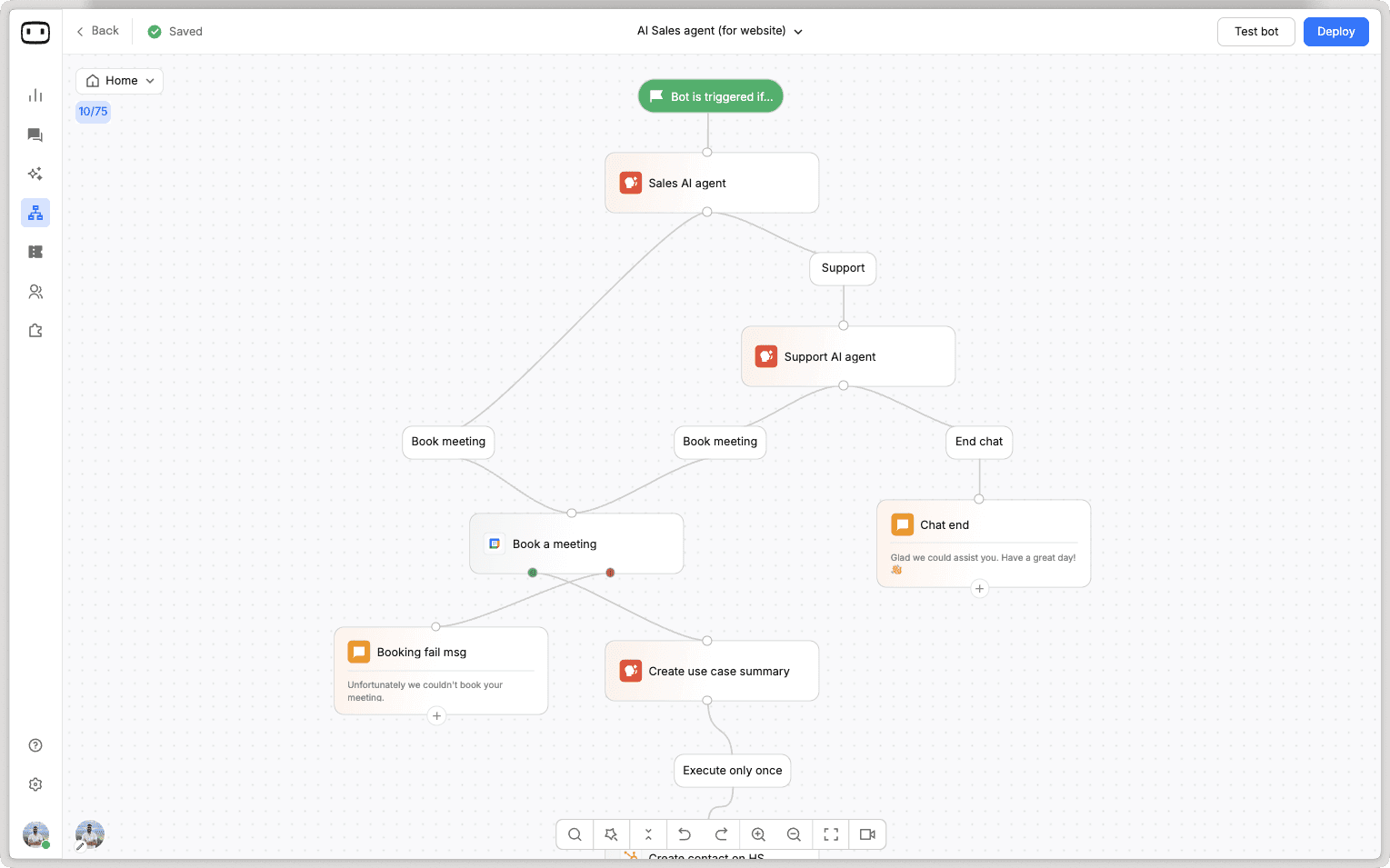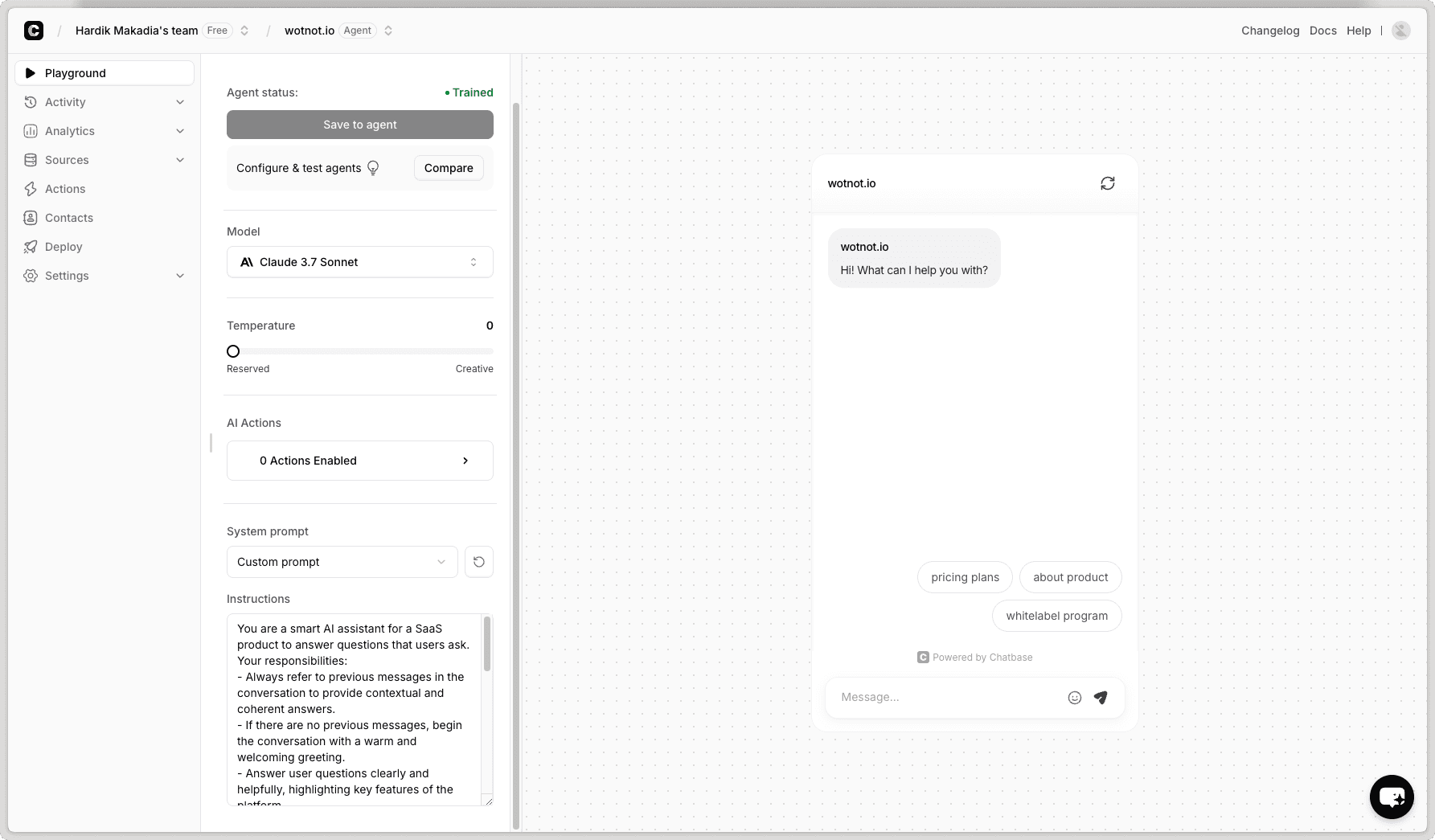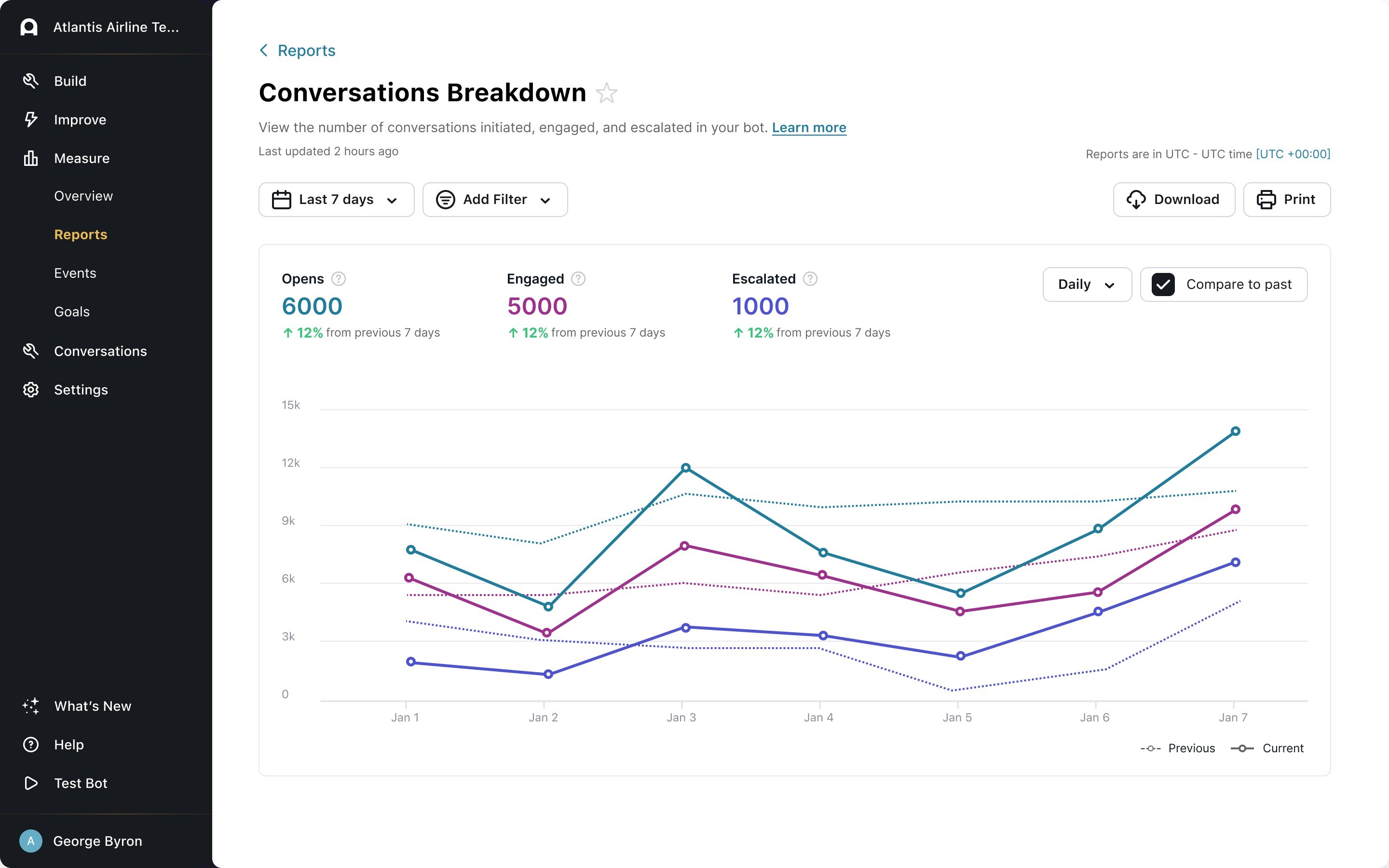
Let’s build your chatbot today!
Launch a no-code WotNot agent and reclaim your hours.
*Takes you to quick 2-step signup.
In recent years, there has been an increasing demand for chatbots, primarily because companies see that they can be a great help in customer service and make operations more efficient. However, nowadays there are so many chatbot platforms that it is rather difficult to know which one to go for. With so many features and options available, some platforms can feel overwhelming to new users. The right chatbot maker can be a powerful tool for your business, whether it’s for customer support, marketing automation, or creating conversational AI experiences.
In this guide, I am going to tell you about the chatbot platforms I have used, and based on genuine business requirements, the best ones will be compared. No matter if your business is a small one or a big one, I will guide you in choosing a tool that fits your needs and growth.
Why Chatbot Builders Matter Today
Chatbots have moved beyond being just a trendy feature on websites. They are now a must-have for companies that are looking at ways of improving customer engagement, getting support through automation, and even increasing sales. With the rise of AI technology and no-code tools, modern chatbot builders leverage artificial intelligence and advanced AI features to understand user intent, enabling more accurate and automated customer interactions. This transformation is great for businesses of any size.
I have gone through many tools, and as a result, I have only kept those that I would very confidently recommend. This article will introduce you to the best chatbot solution providers that can help a business improve its customer experience.
Call-to-action (CTA): Regardless of whether you are a small business or you represent a large corporation, and whatever your needs are, there is the best chatbot builder for your business. Select the one that fits your use case and scale.
What Is a Conversational AI Chatbot Builder?
Simply put, a chatbot builder is a platform through which a business can build and launch a chatbot without the need to have deep knowledge of coding. These builders mainly offer drag-and-drop interfaces, scripting options, or LLM-powered logic (large language models) for natural language processing. Many platforms also provide a visual builder or flow builder, enabling users to design and customize conversational flows without any coding skills.
If you want, you can even have a chatbot conversation that is visually designed with no coding at all, or if you are more technically inclined and need advanced customization, you can go for scripting. Most platforms have third-party tools integrations that facilitate connecting the chatbot to your existing tech stack, and seamless integration with existing tools is a key advantage of modern chatbot builders.
Learn more about GPT Builders.
What I Mean by “Chatbot Builders” (Before We Dive In)
To compare chatbot platforms effectively, it is important first to differentiate between various types of tools available in the market today. Below are what I consider chatbot builders:
Full Dev Frameworks: These are platforms like Rasa and Bot Framework that provide extensive control and flexibility but also require advanced technical skills to set up and manage them.
All-in-One Customer Platforms with Built-in Bots: Tools such as Intercom and HubSpot that are inclusive of chatbot functionality within a CRM or customer support platform, thus, easier to integrate but less flexible compared to standalone solutions.
Standalone Chatbot Builders with No-Code Editors: Examples of such platforms include WotNot and Chatbase, which allow businesses to build chatbots with little or no technical expertise. These platforms are especially suitable for non technical users who want to build chatbots quickly using drag-and-drop interfaces and minimal configuration. These are great options for teams that require fast, customizable solutions without programming skills.
In addition to dedicated chatbot builders, chatbots can also be built using other apps, such as customer support platforms or CRM systems, providing added versatility for different business needs.
Who is the target audience for this guide? It primarily addresses the needs of marketers, customer experience teams, and product managers who want to deploy chatbots fast and efficiently without depending on large engineering teams.
What to Look for in a Chatbot Builder?
There are a few things that you need to weigh before settling on a chatbot platform. This way, you can be sure that your choice is the best fit for your business:
Price: Will the platform be within your budget? Is there a free trial or a flexible pricing plan that suits your requirements?
Security: How safe is the platform? Does it adhere to data protection laws such as GDPR?
Scalability: Is it possible for the platform to accommodate your business growth? Aim for a solution that is capable of growing with you.
Integrations: Is the chatbot compatible with your current tools, such as the CRM, helpdesk software, or eCommerce platform?
Omnichannel and Multi-Channel Support: Does the chatbot have the capability to operate on multiple channels, including your website, Facebook Messenger, Instagram live chat, WhatsApp, and other popular platforms? Supporting multiple channels ensures you can maximize customer reach and provide seamless interactions across diverse touchpoints.
Marketing Features and Possibilities: Does the platform offer marketing features such as lead generation, customer engagement tools, and social media integration? Consider the marketing possibilities available, especially if you plan to use the chatbot for outreach and promotional activities on platforms like Facebook, Instagram, and WhatsApp.
Comparing the Best Chatbot Builders at a Glance
Tool | Best For | Pricing |
|---|---|---|
WotNot | SMBs and growing businesses looking for a powerful no-code chatbot with high customization and integrations | Starts at $19/month |
Chatbase | Quick FAQ and knowledge-base chatbots with minimal setup | Free plan available, paid plans start at $40/month |
Voiceflow | Teams building voice assistants and multimodal conversational experiences | Free plan available, paid plans start at $60/month |
Landbot | Lead generation, forms, surveys, and interactive conversational flows | Starts at $30/month |
Ada | Large enterprises with high-volume customer support automation needs | Custom pricing |
Fin (by Intercom) | Customer support teams already using Intercom | Starts at $39/month per seat |
Botpress | Technical teams needing advanced AI workflows and full control | Free plan available, enterprise pricing is usage-based |
ManyChat | Social media marketing automation on Instagram, WhatsApp, and Facebook | Free plan available, paid plans start at $15/month |
Best Chatbot Builders for All Businesses
1. WotNot

WotNot is a flexible platform that has a chatbot builder that any business can use, especially when the business requires a high degree of customization but doesn’t want to carry out lots of development work. WotNot is known for its no-code drag-and-drop interface, which features a visual builder and flow builder for designing conversational workflows without coding. It can also automate repetitive tasks, freeing up human agents for more complex issues.
What I Like:
User-friendly drag-and-drop interface with a visual builder and flow builder.
More than 50 different tools are integrated.
Being scalable allows it to accommodate any business, small or big.
Allows businesses to add unlimited custom fields for greater personalization.
Efficiently automates repetitive tasks to improve customer support.
Where It Fell Short:
Some advanced features need more time to get familiar.
No AI machine is embedded in the product for understanding customer conversations; therefore, you will have to leverage third-party tools.
Who should use it: SMEs that want to get a powerful chatbot builder without coding requirements.
Pricing: Subscriptions cost from $19/month onwards, depending on the use.
Start building, not just reading
Build AI chatbots and agents with WotNot and see how easily they work in real conversations.

Start building, not just reading
Build AI chatbots and agents with WotNot and see how easily they work in real conversations.

Start building, not just reading
Build AI chatbots and agents with WotNot and see how easily they work in real conversations.

2. Chatbase

Chatbase is for companies that want to have their chatbots ready in no time by simply uploading documents, uploaded files, and website links for training.
What I Like:
Fast launch and requires minimal setup.
So simple to use that even a rookie can handle it.
Allows users to train chatbots using uploaded files and website links, enhancing the chatbot’s ability to provide accurate and relevant responses.
Where It Fell Short:
Its customizations are so minimal compared to the other.
Designed for mostly Q&A.
Lacks marketing possibilities on popular social media platforms such as WhatsApp, Facebook, and Instagram, limiting its scope for social media marketing and outreach.
Who should use it: Companies that are new to the world of chatbots and require the simplest solution.
Pricing: Has a free plan, and the first paid plan is at $40/month.
3. Voiceflow

Talking multi-modal conversations, especially voice, has made Voiceflow ideal for teams that are collaborating with voice assistants or multi-platform experiences.
What I Like:
It can be combined well with voice assistants such as Alexa and Google Assistant.
The use of AI technologies to come up with a voice experience is very high.
Voiceflow leverages advanced AI models to power its voice and conversational experiences.
Where It Fell Short: chatbot platform
Only the website and voice are supported; multi-channel is not yet available.
This software will not be a good choice for the enterprises that intend to provide customer care through chat and not voice.
Who Should Use It: Teams working on creating voice experiences or multi-modal chatbot development.
Pricing: Free plan available, paid plans start at $60/month.
4. Landbot

Landbot is mainly recognized for its unconventional way of combining interactive flow with form-like layouts to make conversations appear lively and engaging. It is the right fit for organizations intending to automate their lead generation or customer support via simple and structured interactions, especially those aiming to collect leads and qualify leads efficiently.
What I Like:
Extremely interactive and engaging, which is totally beneficial for converting potential customers.
Provides a no-code interface along with drag-and-drop features.
Enables integration with forms and surveys, making it the perfect solution for companies that collect data, collect leads, and qualify leads through interactive forms and surveys.
Offers basic analytics to help users track chatbot performance and gain insights into user interactions.
Where It Fell Short:
Not enough customization options for complicated conversational flows.
Possibly, not the right tool if a company is interested in AI conversations with great depth.
Who Should Use It: Any company that is looking for a simple, user-friendly, and interactive chatbot for forms, surveys, and lead generation without involving technical tasks.
Pricing: The plans start from $30/month, and the prices are quite flexible depending on your requirements.
Best Chatbot Builders for Enterprise
When choosing the best chatbot builder for enterprise needs, it's important to look for platforms that offer advanced features such as AI agents capable of handling complex workflows. Enterprise chatbot builders should also provide consistent support across languages and channels, ensuring reliable and uniform assistance for customers worldwide. These capabilities are essential for large organizations that require seamless communication and efficient automation at scale.
5. Ada

Ada is a top-tier AI-driven chatbot that automates customer support on a large scale. It accurately interprets user intent using an advanced NLU engine and leverages past interactions to personalize responses. Ada can also escalate complex issues to human agents when needed, making it an excellent fit for large organizations with massive customer support requirements.
What I Like:
An advanced AI system, suitable for automating customer support of a very high volume.
Utilizes an advanced NLU engine to interpret user intent accurately and leverages past interactions for more personalized responses.
Allows for deep customization of the bot's persona and tone to align with brand identity.
Supports over 50 languages, ensuring consistent support for international audiences.
Security of analytics and reporting features.
Where It Fell Short:
Complicated setup procedure.
This aspect is that pricing can be a problem for smaller teams.
Who Should Use It: Large enterprises with heavy customer service and support needs.
Pricing: Custom pricing based on needs.
6. Fin by Intercom

Fin, compatible with Intercom, is a chatbot developed for larger customer service teams. Hence, it makes sense for companies already utilizing Intercom to choose this option.
What I Like:
Integrated with Intercom, thus perfectly fitting into the existing toolset.
Designed to efficiently handle customer questions and customer queries, reducing support workload and improving engagement.
Supports multi channel support for enterprise customer service teams.
Excellent provision of reporting features.
Where It Fell Short:
Very little use outside the Intercom platform.
Who Should Use It: Teams already using Intercom as their primary CX platform who are interested in exploring lead generation chatbot strategies.
Pricing: Starts at $39/month per seat.
7. Botpress

Among other things, Botpress comes with extensive options for personalization and, therefore, is ideal for companies that want to have AI-driven bots capable of complex scenarios and advanced integrations. Botpress is recognized as the most powerful AI chatbot builder tested, offering a powerful chatbot builder that allows extensive customization and advanced logic. Its open architecture enables developers to connect to any large language model (LLM) or API.
What I Like:
Open-source and extensively customizable.
Works excellently for businesses that require complex workflows.
Supports AI actions, enabling bots to perform automated tasks and integrate with external services.
Where It Fell Short:
It is less friendly to beginners compared to alternative options.
Technical knowledge is required.
Botpress has a steep learning curve and high learning curve due to its advanced features and customization options.
Who Should Use It: Large teams with in-house technical expertise needing advanced features.
Pricing: Free plan available, with pay-as-you-go pricing for enterprise solutions.
Learn more about Enterprise Chatbot Platforms.
Choosing the Right Chatbot Builder for Businesses
Deciding on which chatbot builder to use require that you first of all understand your major use case. Here are the suggestions in brief:
For a startup business: Go for a WotNot-like platform without code for a good user experience and quick launch.
For mid-stage companies: Take into account AI-driven tools such as Chatbase or Voiceflow, which are good for business scaling.
For large-scale businesses: Search for advanced features and integration capabilities, for example, solutions like Ada or Botpress.
For highly regulated industries: Select customized, high-security, and enterprise-grade platforms that meet compliance standards.
Common Mistakes I See When Teams Pick Chatbot Builders
Choosing the wrong chatbot builder can lead to inefficiencies, missed opportunities, and a poor user experience, so it's essential to avoid common mistakes when selecting the right platform.
Choosing a chatbot builder just because of AI hype: People get excited about AI so that they forget the most important thing – that a tool should fit their workflow and goals.
Not valuing content/knowledge base enough: The majority of businesses just don’t have a clue that a good knowledge base is essential if they want their chatbot to be really effective.
Not preparing for human handoff: Even though chatbots are able to do a lot of things, a person will still always be needed. Make sure the solution you choose has live chat functionality.
Overlooking analytics: Chatbots are constantly improved through feedback. Don’t ignore analytics and performance tracking.
Getting stuck in a closed ecosystem: Go for a chatbot builder that provides you with the option of flexibility and migration, especially if scaling is in your plans.
Learn more about Top Chatbot Development Companies.
My Recommendations by Scenario (Quick Cheatsheet)
Here’s a quick guide to help you choose the best chatbot builder based on your specific business needs and goals.
If you want only one chatbot creator to take care of pretty much everything: WotNot is perfect for any size business looking for a WordPress chatbot.
If you’re thinking about an instant FAQ bot: Chatbase provides you with an easy and quick setup, and the best Q&A functionality.
If you want full control over the bot and don’t mind the complexity: Botpress software gives you the flexibility and the power to create complex workflows.
If you want to mainly focus on social media: Manychat will be your perfect partner in automating marketing on platforms like Instagram, WhatsApp, and Facebook.
If your priority is offering voice experiences: Voiceflow is a leader in this domain, which makes it perfect for businesses that are using voice assistants.
FAQs
FAQs
FAQs
Do I need developers/coding skills to use a chatbot builder?
Do I need developers/coding skills to use a chatbot builder?
Do I need developers/coding skills to use a chatbot builder?
How much do good chatbot builders typically cost?
How much do good chatbot builders typically cost?
How much do good chatbot builders typically cost?
Can chatbot builders integrate with other third-party tools?
Can chatbot builders integrate with other third-party tools?
Can chatbot builders integrate with other third-party tools?
Can one chatbot builder handle both support and marketing?
Can one chatbot builder handle both support and marketing?
Can one chatbot builder handle both support and marketing?
Are open-source chatbot builders worth it for most teams?
Are open-source chatbot builders worth it for most teams?
Are open-source chatbot builders worth it for most teams?
ABOUT AUTHOR



Hardik Makadia
Co-founder & CEO, WotNot
Hardik leads the company with a focus on sales, innovation, and customer-centric solutions. Passionate about problem-solving, he drives business growth by delivering impactful and scalable solutions for clients.

Start building your chatbots today!
Curious to know how WotNot can help you? Let’s talk.

Start building your chatbots today!
Curious to know how WotNot can help you? Let’s talk.

Start building your chatbots today!
Curious to know how WotNot can help you? Let’s talk.



